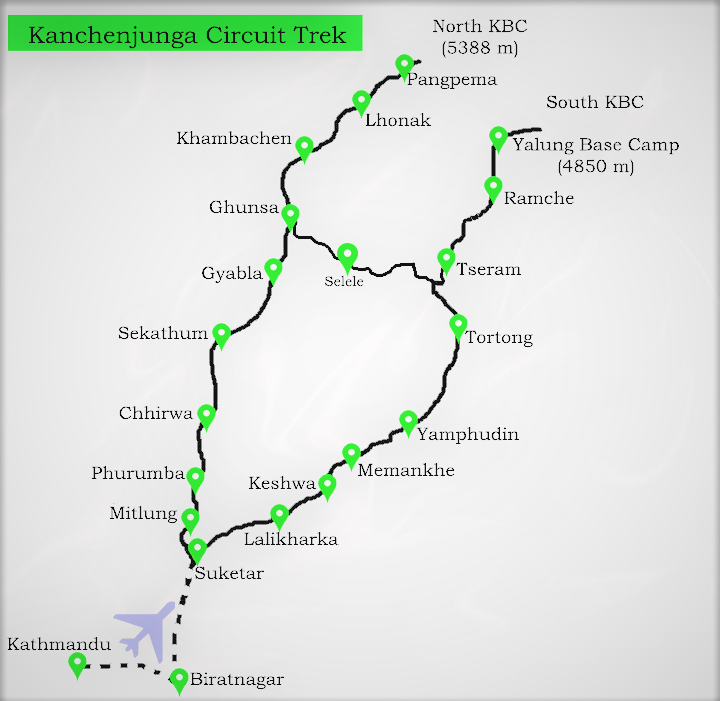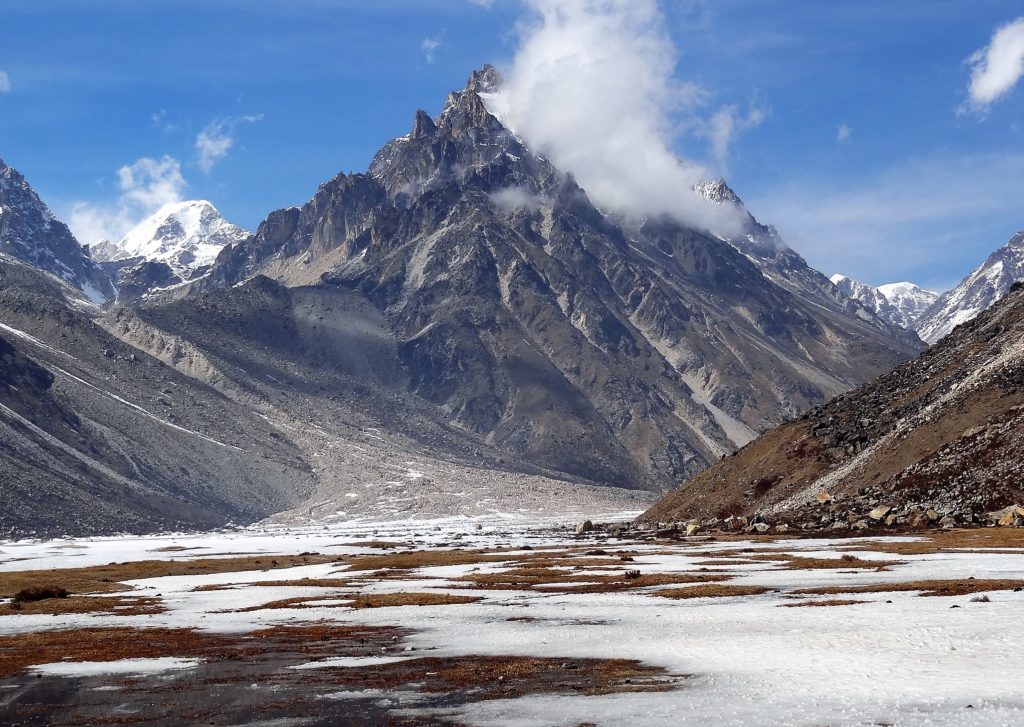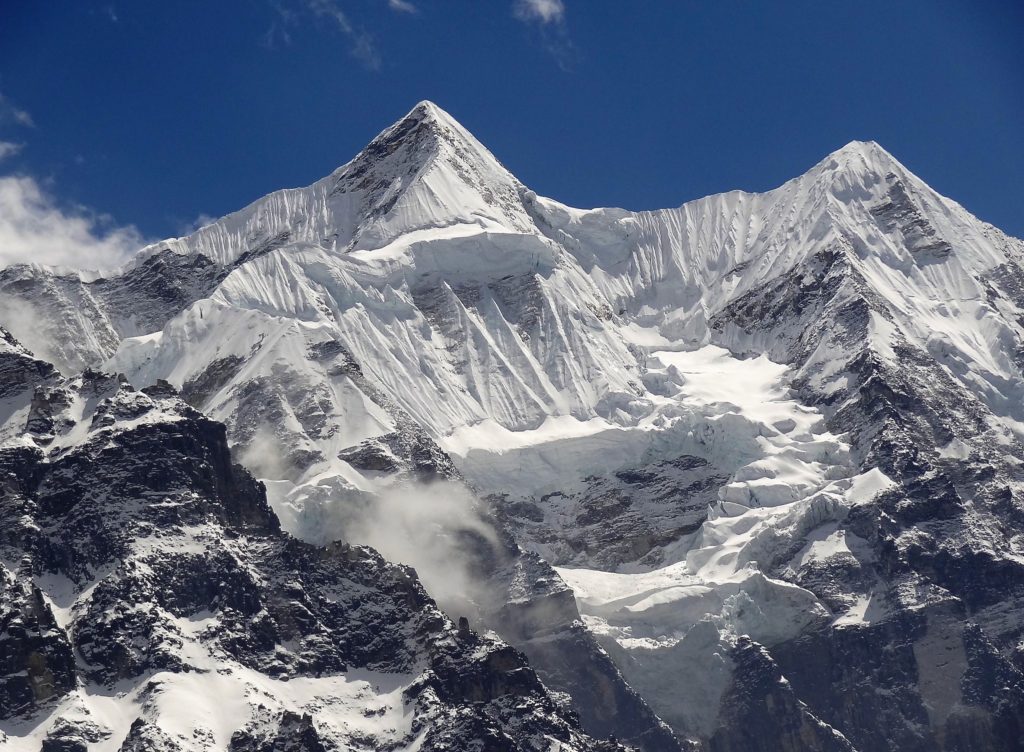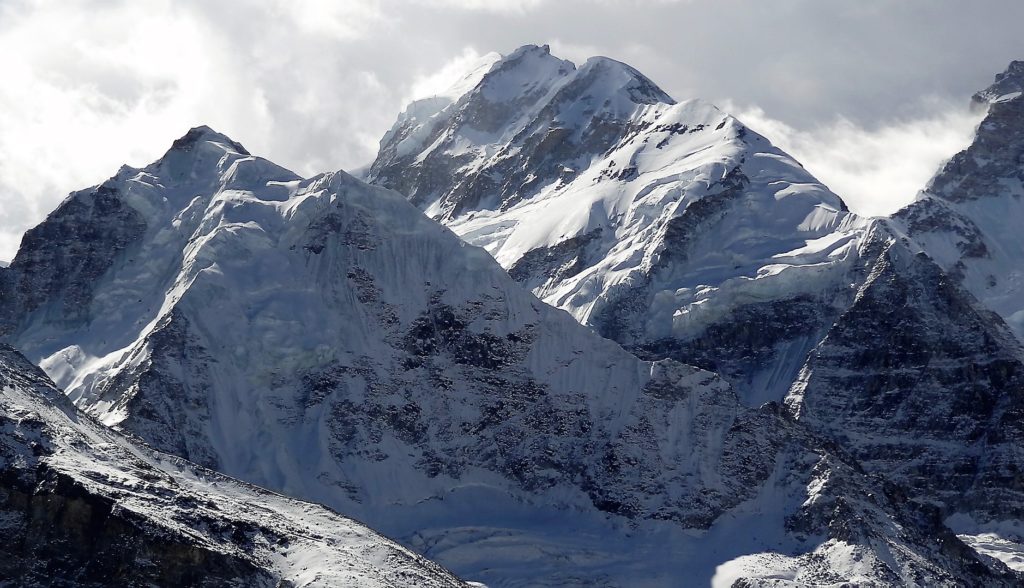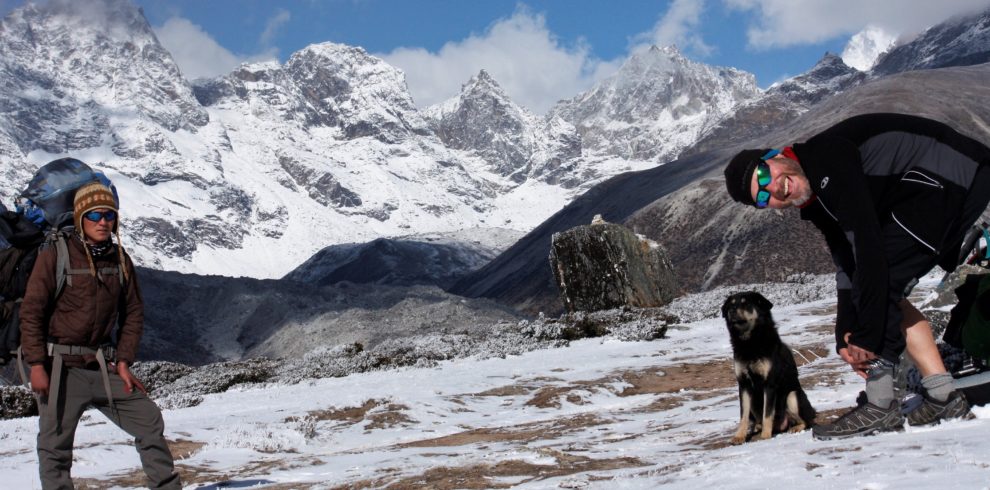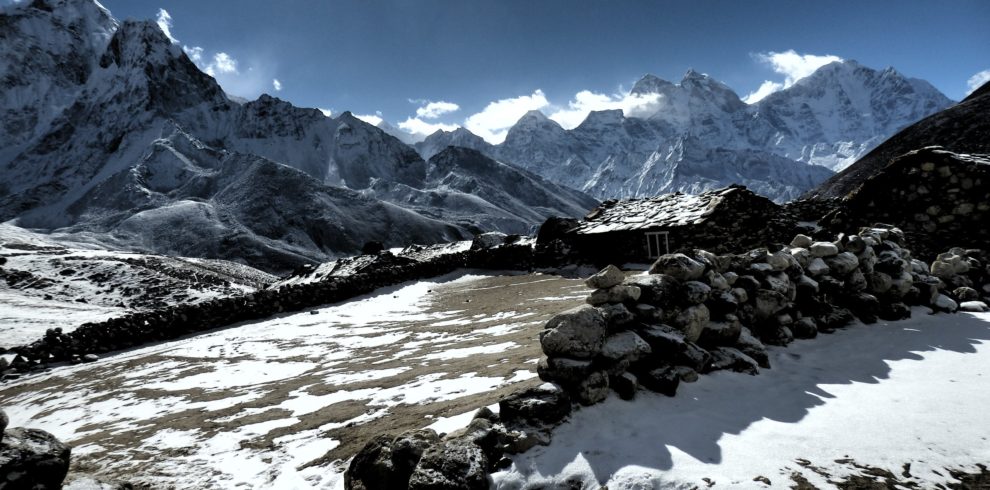Mt. Kanchenjunga, the word is derived from the Tibetan word originates to five great Treasures of the snow. This word symbolizes the five peaks as gold silver, precious stones, grains, and Holy Scriptures. Kanchenjunga Circuit Trek is one of the famous and adventurous treks in Nepal. Even though the hidden Kanchenjunga base camp trek is not famous as Everest and Annapurna Base camp. KCA is a preserved park set between Far- Eastern part of Nepal.
The beauty of hidden nature let rendezvous with old remote Nepali traditions and lifestyles. Moreover, its ancient form is not much crowded and still remote to the modern world. Trekkers were allowed only after 1988AD in this Kanchenjunga circuit route. It is a popular emerging Teahouse trekking in Nepal. That makes trips accessible and cheap for all the classes. Moreover, it means having small lodges with the least variety of food. Kanchenjunga Circuit permitted us many side peaks excursion as a viewpoint.
This Kanchenjunga Circuit Trek is slightly difficult than Manaslu Trek. So, we suggest you good shape and exercise. Thus, This trek is perfect for high altitude Himalayan journey in Nepal. Kanchenjunga South base camp route is comfortable then north base camp. So to do it we have to need a great level of physical standard.
Kanchenjunga Trek Difficulty
Kanchenjunga Circuit Tek route includes two tracks: Southern Pangpema and Northern Oktang base camp. Trek may include both on the same trip by calling the circuit. Around Trekking contains different diversity and irregularity of landscape. Additionally, trek withholds the best and heart-melting views of Mt. Makalu and Mt. Everest. There are plenty of wildlife resources, the natural endowment of Flora and fauna.
We can enjoy the view of mountains and glaciers from both paths. Drive to third highest Himalayas hosts several species such as Pheasant, Dragon, Snow leopard, Black Bear, and Red panda.
During the trek, we will meet amazing people around Amphuding and Manangthe. Kanchenjunga trek accommodation will host in small stone huts. Most of the locality may not exist during the years so route might close in winter. However, the South base camp has a beautiful scenario of peaks, glaciers, and landscape more variation. More, Kanchenjunga solo trek is possible with a private guide. But we have to catch up with someone’s traveler to join the permit.
A flight must be taken from Kathmandu to Bhadrapur is about 45 min. Next, we ride a jeep to until few hours to Taplenjung. while back to from Hobokhola it normally took 6 hours to reach Birtamod. After that finally, we will start our trekking.
Overview
Real Facts and highlights of the Kanchenjunga Base Camp Trek
Mount Kanchenjunga- the third highest peak in the world
Tibetan hospitality and livelihood
Traditional Nepali cultures with remoteness and untouched natural heritages trek
Home of Wildlife such as Snow leopard, Musk deer, Red panda, etc.
Different landscapes and forests to meadows
Many Snow-capped peaks above 8000m
North-South Kanchenjunga base camp glacier and many others.
Trek natural information
Many Rivers and Natural waterfalls. Mammal species within the Kanchenjunga conservation area famous for include the snow leopard, spectacled bear, and red panda. Moreover, many Birds species include the golden snow cock, blood pheasant, and red-billed chough. In 2012 documentary a snowcat was photographed at an elevation of 4,500m.
Itinerary
The early day we start tour if we want Pashupatinath temple, Swayambhunath stupa and Bouddhanath stupa which are all world heritage sites. The Durbar Square sheds light on the life of the Gorkha royals in ancient times, which we can explore by some short of hiking, Pashupatinath temple is one of the most important places of pilgrimage for all Hindus religious. Swayambhunath is also known as the Monkey Temple and Boudhanath Stupa is one of the largest stupas in the world, where we can view most of the valley and surrounding mountains. At noon, we are introduced to our trekking guide team and discuss the trek in Everest hiker team. Overnight in Kathmandu.
Include Bed and Breakfast
Today we took early flight for the trek to Bhardapur airport. After landing there we directly head towards to Taplenjung on the jeep. We can see the famous tea garden in Nepal on the way. It would be a superb day with the best road trip.
We will read to Lalikharka by 5 hours of trekking. Lalikharka is a beautiful village in Panchthar District in the Mechi Zone of eastern Nepal. It is a simultaneous ascent and descent on a trail that mostly passes through lush green forests all the way to Lalikharkha
Included meals: Breakfast Lunch Dinner
After breakfast, we start to walk all the way little up until hill. By the time when we rich the Hill we walk all the natural straight until reach to steam. Furthermore, we will have lunch at Thiwachirwa, after we head start to climb up and again need to cross the river. After 2 hours later we will arrive at Thapethik village. Limbu, Cheetri, and Rai occupy this village. Overnight at Tea house of Thapethok...
Included: Breakfast, Lunch dinner.
Since early morning we have to prepare for the long day towards Amjilasa. After breakfast, we slowly head up to Hellok have to cross the river Simbuwa River. Again 45 min later we have another river Gunsa river. Way head up slightly all the way up to until Sakeathum Village. After lunch at we have to walk on Stone step, and there became steeper and we have to care all about 1km until Ghaiyabari we can see the waterfalls. Another 1 and a half hour more to reach Sherpa Village Amjilasa. Overnight at tea house of Amjilasa.
Included: Breakfast, Lunch dinner.
After breakfast, we have to walk in stone step little bit decent. And straight ahead until to cross two different bridge within 20 min walk there is village Thyangyani. From here we can see three different big waterfalls right side of Gunja ver. Just a few mins later walk we will be Tibetan village Gapla village. This old village has many Mani, Monastery and more. When we were there we can explore the village there is a small school and its typical village. Today we can see some mountains all the right sight we will encounter in a coming day.
Overnight at Ghapla. Included: Breakfast, Lunch dinner.
Today after crossing the river, we start day slightly head up in the Rhododendron forest just above the river. Before to reach lunch camp Phale we have to climb about 30min. Phale is beautiful Tibetan refuses village surrounding by many Buddhist cultural Monument. After Lunch, firstly need to cross the bridge, we head another side of the river near to Tasi Gumba. After a few mins, we will be Ghunsa Village.
From here we can see lots of Mountains. There is a Tibetan village. The village has health post and checkpoint to Kanchenjunga route. Overnight at Gunsa village.
Included: Breakfast, Lunch dinner.
The day for acclimation, Ghunsa is just below the Gangadhar 5802m peak, Nunyukla Lachung 6012m peak. Ghunas is a significant settlement of Sherpa. There are few monasteries to spent day and waterfall. We can rest and wash out clothes there. Also, we can go Dudhpokhari to explore all about 5 hours to go up and 2 hours back. Overnight at Gunsa
Included: Breakfast, Lunch dinner.
After breakfast, we walk inside alpine pine Black and blue pine forest before crossing river three bridge to reach RambuKharaka. Moreover, there is rock falls, waterfalls an hour and a half walk all the way up until Khambachen. Beautiful town and the scenic viewpoint where we can see lots of peak and Kumbhakarana glaciers. We can see 4 different Kumvakarna mountains and other glaciers. There is a basic tea house lodge for overnight. Today we surely enjoy the walk but need to walk a slow rhythm. Overnight at Khamachen.
Included: Breakfast, Lunch dinner.
After breakfast, we walk on a rocky trail on moraine Glacier. There on the left side of rocky Tibetan plateau Ramdang Old monastery delights us beautiful scenery opposite right side there are Kanchenjunga glaciers.
After two hours walk, we can see dry glaciers lake and The Stone Hurt Lonak welcome us. We will see a 360-degree panoramic view of many Kanchenjunga peaks. Overnight at Lonak village
Included: Breakfast, Lunch dinner.
After breakfast the early morning we walk all the way towards marine glaciers until Kanchenjunga base camp. We can see three glaciers, Langpo, Pathibhara, and Kanchenjunga. We can see many views of the mountains. We will be delighted by Janu peak, Kangbaachen, Yalung Kang, Ramtang peak, wedge peak, Drohmo peak, Thangkonama peak, Langchung Khang, Nepal peak 1, 2, more. After stunning view we back to Lonak for overnight.
Note: Above itinerary allows time to climb Ri at Pang Pema its about 5848m. if you want to explore could we do it? Explore both base camp and Peak climbing is worth. To go there we have hired a local guide with tea and lunch. All the way 10 to 12 hours journey from the top.
Included: Breakfast, Lunch dinner.
After lunch, we came back for such base camp towards the same way to Ghunsa. We surely enjoy the magnificent view of the mountains. We are preparing for flowing day towards south Kanchenjunga base camp via sele pass. Overnight at Ghunsa.
Included: Breakfast, Lunch dinner.
After breakfast, we walk gradually up inside the jungle. During the day we can see oppositive of Gapla village, Olanjung gola view of down the valley. Also, we can Tibetan Mountains from sele pass of Kanchenjunga trek. After reaching the top we slightly walk easy way up and down and we finally pass Kanchenjunga sele pass. During top, we can see Mt Everest, Kanchenjunga, and Mt Makalu. And for camp 45 min more walking we will reach the campsite. View from the top was splendid with much Mahalagur range. Overnight at Sele
Included: Breakfast, Lunch dinner.
After breakfast, day start with climbing until to reach the pass, we have to walk about 2 hours to get the Mirginla pass. Again the view is rewarding, mountains vista from atop the hill, Makalu Everest, Kanchenjunga many more. After the top, we walk gradually up and down towards Cheram. The last section we continued down towards 2 hours descends to reach the campsite. Overnight at Cheram
Included: Breakfast, Lunch dinner.
Today we head towards Kanchenjunga south base camp. We will go for view Oktang, Oktang Viewpoint famous for the spectacular view. We can see many views of the Kanchenjunga Mountains and glaciers Kanchenjunga south base camp. After exploring the beauty of the mountains we back to Cheram for an overnight stay. Today we can see Yalung base camp. Kanchenjunga and Younglung Khang view. Many mountains. Overnight at Oktang
Included: Breakfast, Lunch dinner.
Today we walk All the way descend inside forest make trip beautiful; will be grateful all day and finally Tortang for an overnight stay. Overnight at Tortang.
Included: Breakfast, Lunch dinner.
Since early morning, we have to climb up to Chatrakhara, 3646m. There is lunch camp. Afterward, we have to go down all the way until Yampuding. Overnight at Yampuding.
Included: Breakfast, Lunch dinner.
After breakfast, our day starts inside the typical countryside of Nepal. All the way usual downside of villagers we will pass many villagers along the way. We will stay at Homestay.
Overnight Khabang village. Included: Breakfast, Lunch dinner.
Firstly slightly straight and descend Khebang Khola. Furthermore, we head gradually up we climb until lunch and for the rest of the trek. Overnight local typical guest house of mountains. We will enjoy the trip another day we are preparing to back the city.
Included: Breakfast, Lunch dinner.
We head towards Birtamod the same place we start the trek. Today we will surely enjoy the spectacular view of tea garden known for Illam Tea in the world. We surely enjoy the view of the mountains. We can see mount Kanchenjunga once again. Overnight at Birtamod.
Today we wake up early and head towards to airport for Kathmandu flight. After arriving Thamel is yours for enjoys a successful trip. A later evening we will enjoy the dinner with guide and team.
Cost Include
- Airport / pick up & transfer by car / Van.
- Domestic flight ticket KTM/Tumlingtar both way domestic airport tax
- 3 nights’ accommodation with breakfast at a 3*** hotel in Kathmandu.
- Meals (breakfast, lunch, and dinner).
- Tea Lodge and Tented accommodation during the trek.
- All transportation by private transport.
- Kanchenjunga National Park Permit and all necessary permits.
- Guide & support staff and their insurance and salary, foods, transport.
- The required number of local staff and porters to carry your luggage during the trek (We assign one porter for every two guests).
- Office Service charges and governments.
Cost doesn't include
- Any meals in Kathmandu Beside breakfast.
- Travel insurance (we would significantly be happy to assist).
- Both way International airfare
- Nepal Tourist Visa fee and more.
- Items and expenses of personal natures.
- Any kind of hot drinks, alcoholic drinks, cold drinks, phone calls, internet Etc.
- Personal Trekking Equipment’s like sleeping bags, jackets
- Emergency Evacuation (Helicopter Rescue).
- Any other costs that are not mentioned in the cost included list.
- Tips for guide, porters, driver...
- Any costs which arise due to a change of the itinerary, due to landslides, political disturbance, and strikes, etc.
Check Gear list for Kanchenjunga Base Camp Trek
In most of the causes before start our adventure, we’ll spend a day or part of a day doing some casual sightseeing in world heritage site valley surrounding before we leave for the trek, and we’ll check gear when you arrive if anyone needs for the trek. Please have photos, passport photocopy airline tickets to re-confirm and insurance information ready if needed. Let’s us detail.
Recommend Day-pack for Kanchenjunga Trek
We recommend a 30-45 liter Day-pack for each in case of porter hiring. Better to have it too large than too small, as on pass days you’ll want to carry more when you need. Most have internal water bladders built in, which are good to have it for any situation. Make sure it’s comfortable before leaving home. Mines are 55 and 65 liters.
Generally if you are going to hire porter in your daypack, you’ll be carrying 1 or 2 liters of water, a wind/Gortex/soft/ hard-shell jacket, wind/rain pants, hat & gloves, extra socks, sunscreen, snacks, water purifying tablets or filter, camera, a plastic bag or pack-cover and maybe a down jacket. Others remaining porter will assist you.
Packing/Storage
It’s easiest to pack and unpack from a duffel-bag, do for the most natural, porters to carry as well… Inexpensive and/or sound quality duffel are available in Kathmandu, but we can provide upon your request but it’s best to invest in a robust and waterproof duffel such as a North Face. You can leave/store extra gear in Kathmandu at our office storage room free of charge.
Extra Gear & Villagers
If anyone has old/extra/used gear of any sort, bring it along if you have room in your duffel you can donate it for porters and some orphans center or donation for villagers.
Our porters & staff also appreciate it can be old shirts, jackets, pants, fleeces, shoes to your old trekking socks. We often have a raffle on the first day of the trek, and each porter will get at least one ‘new’ thing, which is fun for them.
Recommend Snacks for Kanchenjunga trek
It’s always good to have some snicker or bars at lower elevations. You crave terrific things at altitude, and often need energy in a way that you usually don’t at lower altitudes energy bars, electrolytes, etc are essential for long days or passes. Lemonade mix, Emergen-C, Tang, etc great to have for hot days in your water bottles it can make huge differ. If anyone has a favorite cookie/biscuit, bring a package to share in the tent in the evenings with staff if you want. And anything else that you can bring particularly likes.
Water Purifiers & Filters
You can bring an MSR ceramic purifying/filtering pump along on the trek which everyone can use to pump fresh water in the evenings for the next day’s drinking water, ecologically the best way to get water in the Himalaya’s fragile trekking regions. Bring your pump, UV purifier or iodine tablets to have the capacity for fresh water whenever you want in route. Please bring at least unbreakable plastic/metal water bottles.
What we need for Kanchenjunga base camp trek
A copy of your travel medical insurance (just one sheet with policy number, name, and international contact numbers) as well as password photocopy.
A copy of your Passport (front page) and Nepal visa
3 Visa-sized photo
Cash for Kanchenjunga Trek
We run trek basis on beautiful during the trek for drinks, snacks, candy bars, biscuits, beer, etc. There’s some good shopping in Namche, sometimes a chance to buy locally made products. For tipping the crew we recommend about $100 per person in Nepali rupees or USD. There are ATMs in KTM which give you 350 USD, and many money changers, banks, etc available in Kathmandu and Lukla. In Namchhe, you can change TCs or cash, and some other places cash but we recommend you do it in Kathmandu. Guide also have extra rupees with them if anyone runs out and needs to borrow. For each Everest hiker, $250 is an excellent amount to change when you arrive in KTM.
Camera/ mobile Batteries recharge system
There are now many places to recharge batteries in the Everest, Annapurna, Manaslu and Langtang region so bring your camera battery chargers otherwise bring your solar panel. We recommend always bringing extra batteries as it takes time to charge and there is often a line in busy time, charging is not always available and it can get expensive to charge your batteries up higher!
Washing & Showers in Kanchenjunga base camp Trek
Showers are almost always available at the small lodges or our team crew will give you bucket hot shower. But they’re not cheap generally per head 3-5USD up to. So budget some extra cash if you like to shower daily! You can have (at no cost) a ‘warm washing bowl’ to wash up with. As for clothes, bring a small package of soap powder, and you can either wash your clothes yourself or laundry available in Namache our porters some money to wash them for you! That sometimes works.
Sleeping bag for Kanchenjunga trek
Down-filled sleeping bags rated to -10º are best because high altitude nights will be fresh for hikers but for peak climber more than…Good down is fluffy, light and thick. A muff makes a big difference to the overall warmth of a bag and a mummy bag is generally warmer than a rectangular one. If your bag is rated for a higher temperature add a fleece sleeping bag liner to add warmth to the alpine zone.
Day-pack for trek
This should be comfortable in your choice, with a right waistband that transfers some of the weight to the hips. It needs to be big enough to take a jacket, fleece, drinking water, camera and odds and ends you might like during the day which should be always with you.
Duffel Bag for Kanchenjunga trek
If you travel with porters, bring your gear in a duffel bag which help to excess easy. Several companies make good duffel bags with a zipper along the side for ease of entry choose the best one. Get a bag that is durable and has a sturdy zipper some time it makes different. A duffel bag 40cm in diameter and about 80cm long is large enough to carry your gear and will usually meet the weight limit of porters and domestic flights rules.
Recommend Trekking Boots, for Makalu-Kanchenjunga trek
To finish happily trek you need comfortable feet. Quality boots have good ankle support, plenty of toe room for long descents, a stiff sole to lessen twisting torsion and are light, due to you don’t tire. Look at the inner lining – leather is good and Cambrelle is even better, a material that eats smelly foot bacteria and makes the extra relief. Good lightweight trekking boots or light all leather boots are ideal for a long day trek. Avoid arriving with brand new boots that you have not yet used before! Walk in your new hiking boots on some steep hills and make it smooth that will test trouble spots before you leave home. The longer the trek, the better the boots you need, so took the best one for a happy journey.
Socks,
In the low country area, your feet will be warm or even hot while walking so quality cotton mix sports socks are excellent. Three to four pairs are enough for the trek. Thick trekking socks are better for higher up because you may walk in the snow, and evenings are cold where you can exchange. We suggest you bring four pairs or even 1 more. Most modern trekking boots fit snugly so wearing two pairs of socks at the same time is impractical to think twice.
Camp Shoes,
Luxury for your feet at the end of the day: sandals or running shoes is the best idea.
Fleece top,
Most trekkers consider this is essential, but alternatives are a thick thermal top or a light down jacket. In Kathmandu, you can get cheap Korean fleeces but they are not the best quality you needed.
Down Jacket or fiber-filled jacket,
Down clothing has the advantage of being light and compressible for alpine. A down jacket will stuff into a small space when packed, yet puff up. You should bring a good down jacket on all treks from your country or can buy in Kathmandu. Most ski jackets that have been used in your country are not warm enough and most so-called expedition parkas are too heavy and bulky. Don’t bring both a heavy and a light down Jacket; choose one that will serve both purposes, preferably ideal one with a hood that is also stuffed with down. If you feel extremely cold at high altitude, you will likely to wear your down jacket inside your sleeping bag.
Wind or rain jacket
During the day trekking, you can use windproof, Waterproof and breathable. Plastic ponchos or non-breathable raincoats are not suitable for the trek.
Fleece/sweatpants,
Great for the chilly evenings, thicker is better and polypro is better than cotton in high.
Day-wear shirt,
T-shirts are favorite but a shirt with a collar and long sleeves are more practical during the day or in the evening. Regularly you can use two so you can swap damp for dry. Look one for shirts made of quick dry fabrics rather than cotton.
Trekking pants,
You will live in these. Light material, loose fitting, and dark-colored are best.
You can survive with only one pair but you have to bring two; get dusty or muddy so a change is a good idea. Cotton cheapies some marks in the local fashion, it is not necessary to have gore-tex or waterproof pants.
Neck gaiter,
For winter trekking they are the best for staying warm you need it, A fleece triangle with a Velcro fastening works well and is easy to pull up when the yaks stir up trail dust.
Trekking poles,
Useful, especially on steep, rough terrain, but if you are not used to using them you will not miss them someone who loves to do photography thinks twice.
Sunglasses,
Highly recommend good one suitable for snow, as it is bright up there, but specialized glacier glasses. Contact lens wearers report very few problems except cleaning them in the conditions it’s your matter. Ski goggles are unnecessary for trekking.
Mittens/Gloves,
These don’t need to be fancy (pockets are the warmest solution to cold hands), so local Kathmandu fleece gloves are excellent but you need it.
Water bottle,
Should be a one-liter size, except boiling water, and be leak-proof. You have to bring 2 or liter capacity in all. Sometimes mini Thomas a metal bottle can double as a hot water bottle on cold nights.
Torch,
LED bulbs are best for mountains. You will need a lamp for reading after dark, and for finding your way to the outhouses. A headlamp is excellent for climbing although many people prefer the second torch it’s enough.
Toiletries and odds and ends,
Bring essentials for the trek only otherwise you can buy in tea houses. There are a surprising number of showers or buckets of hot water available in the hotel. The smallest tube of toothpaste is perfect for a month in your favor. Roll-on deodorant can spare you grief with your tent partner toilet paper need. Hand cleaner in a bottle (“Purelle” or similar) is a good idea, it would be better for the environment than “handy wipes”.
Towel,
Bring only a small one for trekking, or consider using a sarong. Mountain shops sell towels made of a quick dry fabric which is cost around 10USD. In Kathmandu, city hotel do supplies towels. Sunscreen and lip care with sun protection extremely needed during the day sun is intense at altitude, especially after snow, and you will want to use these most days.
Water purification,
One bottle of iodine tablets between two, Douglas or Potable Aqua is the best one. Shops in Canada sell Pristine, which is a good option. We tend to use boiled water from the lodges but occasionally we need to take water from the streams. The use of mineral water bottle is discouraged from an environmental point of view and the higher it cost more.
Snow gaiters
These are not needed, but bring them if you already have some in case we get or cross a pass about 5400M high or you are coming in the winter season.
Evening camp wear,
Around the evening camp, you can wear camp shoes, lights sandals or leather boots. No matter what altitude and what season the temperature can get to -10º after dark. By far the best clothing is:
+ A down jacket, medium weight
+ Thick fleece pants
+ Fleece hat and neck gaiter
+ Thick shoes with wool socks
Available in Kathmandu or bring from home that we need.
1) Sleeping sheet
2) Duffel Bag
3) Trekking pants
4) Wind pants
5) Fleece top
6) Warm hat
7) Light gloves
8) Toilet paper
9) One litter of water bottle
10) Pee bottle
11) Lip care
12) Torch
13) Snow Gaiters
14) Water purification
Bring from home
1) Sleeping bag
2) Daypack
3) Trekking Boots
4) Running shoes
5) Socks
6) Camp shoes
7) Rain jacket
8) Nightwear top
9) Neck gaiter
10) Daywear shirt x2 or 3
11) Underwear
12) Sun hat
13) Sunscreen
14) Sunglasses
15) Toiletries and odds and ends
16) Small towel/sarong
17) Personal medicines
18) Camera
19) Money pouch/belt
20) Passport photos 2x
21) USD40 cash for a visa (30 days visa)
Kanchenjunga info
Kanchenjunga base camp entry permits Restricted area permit issued by Explore Manaslu Ltd It is bordered to the north by the Mahalangur massif of Everest national nature reserve in Tibet.
Kanchenjunga base camp trek needs At least two travelers. The permit can be issued every day but we need for weekly basis and second is the Kanchenjunga conservation projects entry permit.
The Normal permit for Kanchenjunga Conservation Area will be around RS 3000issued by Nepal Tourism Board.
For all the above reasons to do Kanchenjunga base camp, the trek has to be arranged as a fully organized trek through a registered trekking agency hiring at least a guide.
Olangchungola village Around Lelep village around Papung village aroundYamphuding village around The fee for Kanchenjunga restricted area entry permit is currently set at USD 10 per person per week from Government.
The fee for Kanchenjunga conservation area Normal entry permit is currently set at Rs. 3000 per person.
We don’t need a TIMS Card to trek Kanchenjunga. TIMS card is not necessary if you have restricted permit in any trekking region in Nepal.
But we suggest you that TIMS card holding Benefit is for porters group. If your group have Card half of insurance will be covered from Nepal Trekking Association team TAAN. Also if we extend trek furthermore trek route after Kanchenjunga to other destination like Everest then TIMS card is required.
Individuals won’t be able to issue the permit yourself all Nepal restricted area trekking. A locally registered company in Nepal can do it but they must have all tax clear and more.
The following documents are required to obtain the restricted permits
There are numerous police checkpoints throughout Kanchenjunga trekking route to check permits and necessary document. Original passport with a valid visa of from Nepal Government.
A group of at least two people, or passport of your trek buddy. Photos (only required for online submission) any way you need it for another more Normal permit. More required documents for a trek with USD free.
It depends on the individual clients and Travel Company. For any process whatever we called it? We need extra person means two hikers. In the name of the ghost permit, meaning, there will be two permits and need to pay extra for that same as your basis. And you will only go on the Kanchenjunga trek with the single trek. But for this process, we need extra permit original and Valid Nepal Visa for the trek. If your contract travel company have extra hiker they may obtain permit joining with another group. Here the cost is not required. If you are planning a solo trekking, let us know, we will help you to arrange the permit and help you to find a partner.
No Absolutely in a legal way. Whatever a few agencies talk they can do it that it’s all way to under. An original passport with a valid visa of Nepal is must require to issue the permit. But there is another option is if you can send us your flight details and more. Only in an emergency, we can request an immigration officer to give a valid visa after your arrival. We can’t 100% sure.
No Absolutely in a legal way. Whatever a few agencies talk they can do it that it’s all way to under. An original passport with a valid visa of Nepal is must require to issue the permit. But there is another option is if you can send us your flight details and more. Only in an emergency, we can request an immigration officer to give a valid visa after your arrival. We can’t do it legal 100% sure.
Kanchenjunga 8586m is the world’s third-highest mountain in the world. Eastern Nepal is generally more developed and more prosperous western Nepal. This is in part to the more favorable climate with its higher rainfall and in part. To the employment of many Rai and Limbu people in the Gorkha regiments in British and the income and ideas, such experiences bring in Rugged terrain. However, means that mountain areas are especially remote. This area is rich in biodiversity especially the butterflies and other insects in the upper Arun Valley and the stunning rhododendrons of the Milke DandaStunning forests and wild paths at lower altitudes. High passes and trek on glaciers in the immense space of the sparsely inhabited but stunning northern reaches. The warm hospitality of Limbu, Rai and Lhomi communities Rai and Limbu culture. Similarly, classic local drink Tongba, fermented millet seeds to which you add hot water and sip from a wooden pot through a straw.
Kanchenjunga trekking is the most desirable Himalayan trek in the Eastern region of Nepal. It is the trek to the third highest mountain in the world, Kanchenjunga with a peak altitude of 8,586m (28,150ft).
Kanchenjunga trek is rich in flora and fauna 30 varieties of Rhodendron and 69 varieties of orchids are found if we visit during Autumn Basic forest of pine, bamboo, fir, and hemlock is found in lower altitude and higher altitude pines and junipers are rare.
Traditional Brahmins and Chetris are found in a lower trail on the beginning of the journey. Then it has a dense population of Limbu and Sherpa community people until last settlement. Tibetan lifestyle is also found at higher altitude who followed Buddhism.
Moreover, Clothes and foot wares like trekking boots warm slipper, fleece and waterproof jacket, sleeping bag, and trekking poles.
There are four climbing routes literally to reach the summit of Kanchenjunga, most of three are in Nepal from the southwest, northwest, and northeast. And only one from northeastern Sikkim in India until the date northeastern route from Sikkim has been successfully used only three times. Moreover, The Indian government has banned expeditions to Kanchenjunga since 2000.
Nepal Mount Kanchenjunga 8586m also spelled Kanchenjunga. It is the third highest mountain in the world and the Kanchenjunga circuit is best for the trek. It lies between Nepal and Sikkim, with three of the five peaks on the border, and the remaining two West and Kangbachen in Nepal’s Taplejung District.
First highest one Kanchenjunga Main 8,586m, 28,169ft,
Second highest Kangchenjunga West (Yalung Kang) 8,505m, 27,904 ft
Third highest Kanchenjunga South 8,494m, 27,867 ft
Fourth highest Kangchenjunga Central 8,482m, 27,828ft
Firth Highest Kangbachen 7,903m 25,928ft
Mount Kanchenjunga standing at an elevation of 8586m (28169 ft). And contours a giant cross that spans the boundaries of Nepal, Tibet, and the Sikkim. Mainly Mt Kanchenjunga is In Nepal. Only South base camp Glaciers are located Sikkim.
Kanchenjunga trekking is known as adventure seekers seeking to trek with high altitude. We can do this trek in the circuit after back from North. We came towards part by passing Sele pass 4500m. If you love to view untouched natural scenery, primitive way of living, then Kanchenjunga trek is best for a breathtaking view.
Kanchenjunga trek best for outgoing and adventure-oriented souls. Trek to base camp to spend their 2 weeks away from the regular hustle-bustle.
Being a restricted region of Nepal, the solo trek is not allowed everywhere. As well as walking solo explore is high risk in such a wild and uneven topography. Trek demands a companion along the journey or in a group with a registered travel company and guide.
The Kanchenjunga trek starts at lower Terai region. As you progress each day trek, the risk and topography vary and difficult. The trails are rough and uneven in the lower evaluation. The Kanchenjunga Trekking path will be a comfortable basis on less weight of baggage and comfortable shoes. But the more we go up there are lots of seasonal trekking trail, which do change every year. So far, you must have a good pair of boots and socks to deal trail. Furthermore, we need It is your guts and determination to reach Kanchenjunga base that drives you to the end. You need to be ready for at least 6 to 7 hours of a trek in a day.
We will not call this trek the most difficult one. But, being less number of tourists, you will experience a wilderness compared to other areas. So far you need to carry all the necessary personal equipment to make this journey as comfortable as possible.
It belongs to the Himalaya remote region, the lodges are not standard like in the other Tea house trek in Nepal. Moreover, you will get basic tea house facilities to rest after a tiresome day. All the rural Home Stay or Tea House will provide you with ethnic foods.
The best recommended time for Kanchenjunga trek is in autumn (September – November). This is the best time to witness clear weather, perfect temperature, and less slippery trails. And remain best season are in spring (March-May).
